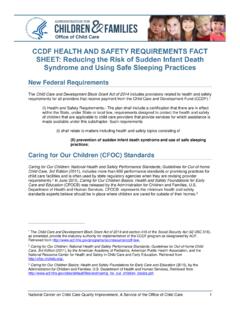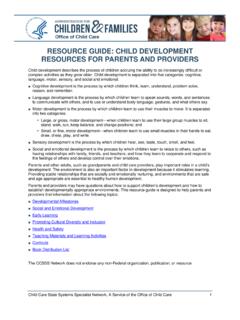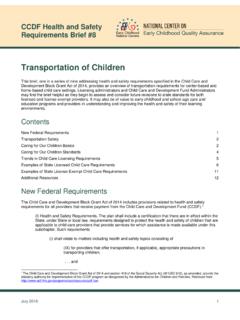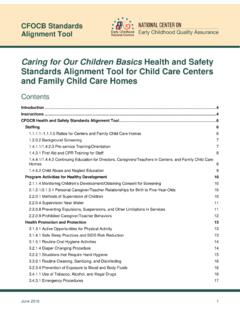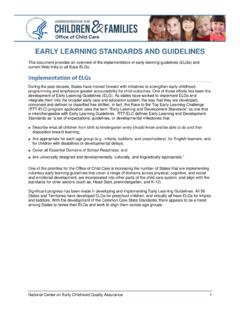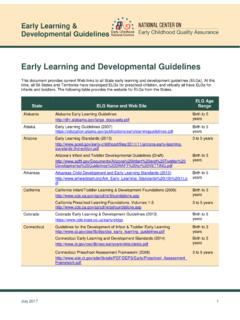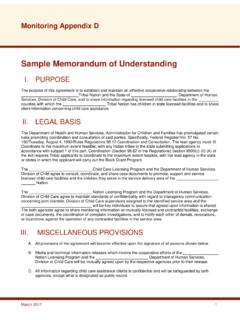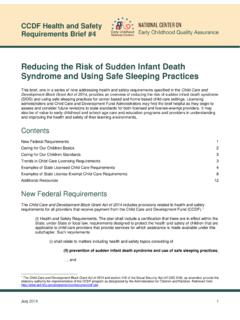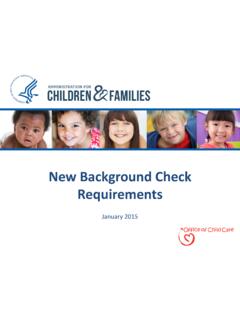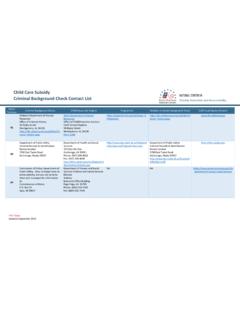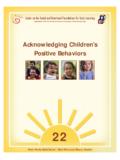Transcription of Infant/Toddler Resource Guide: Planning for Individual ...
1 February 2018 1 Infant/Toddler Resource Guide: Chil d Care Providers Planning for Individual Infants and Toddlers in Group Care Individualized Care Routines and Daily Schedules Consistent routines, activities that happen at about the same time and in about the same way each day, provide comfort and a sense of safety to young children . Whether it is time to play, time for a snack, a nap, or a loved one to return, knowing what will happen next gives babies and toddlers security and emotional stability. Zero To Three (2010, p. 2) Care Routines Caring for an infant or a toddler requires devoting significant time and attention to care routines. In group care settings, with multiple infants and toddlers, care routines are at the heart of every day. A technical assistance paper, Individualizing Care for Infants and Toddlers, from the Early Head Start National Resource Center (EHSNRC) states, Caregiving routines arrival and departure, feeding, meals and snacks, diapering and toileting, dressing, and napping provide a framework for the Infant/Toddler day (EHS NRC, 2014, p.)
2 6). Routines are opportunities for the adult and the child to connect, interact, communicate, and accomplish tasks in cooperation with each other. Routines offer opportunities to build relationships with each infant and toddler that promote attachment and trust (EHS NRC, 2014, p. 6). Also, infants and toddlers are developing a sense of who they are a sense of self. Through individualized care routines with a responsive, trusted adult, each child can learn that he or she is valued, included, and a part of the community. When infants and toddlers are included as active participants during routines such as meals and diapering, they learn about life skills, self-care, and cooperative relationships. According to Zero To Three, Routines provide the two key ingredients necessary for learning: relationships and repetition (Zero To Three, 2010, p.
3 1). Many states require child care programs to have written daily schedules. The National Association for the Education of Young children (NAEYC) encourages practices in which the curriculum guides the development of a daily schedule that is predictable yet flexible and responsive to Individual needs of the children (NAEYC, 2015, p. 9). How do you develop a daily schedule for a group of infants and toddlers who are each on their own timetable? This is an important question because infants and toddlers have not yet developed the ability to manage their own feelings and behavior. For infant and toddler care teachers, creating a daily schedule that is based on responsive care routines makes good sense. Early learning researchers widely agree that adults can best support early learning when a child s interests are central to the learning experience (Shonkoff & Phillips, 2000).
4 Care routines for infants and toddlers, such as diapering, feeding, washing, and sleeping, take up a lot of time each day. Rituals and routines work together to create secure environments that nurture relationships between infants and their caregivers (Gillespie & Peterson, 2012, p. 77). Luckily, important learning and development takes place within these care routines. In fact, the daily schedule is part of the curriculum for infants and toddlers. February 2018 2 Planning for Individual Infants and Toddlers in Group Care Resources California Infant/Toddler Curriculum Framework (2012) is a guide from the California Department of Education contains information on routines. Individualizing Care for Infants and Toddlers Part 1 (Technical Assistance Paper No. 1) (2014) by the Early Head Start National Resource Center provides examples and information about individualizing care routines and coordinating routines between home and the child care program on pp.
5 6 7. Let s Talk About Routines (2017) is the third installment in the Office of Head Start s Caring Connections podcast series from the Head Start Early Childhood Learning & Knowledge Center. This podcast explores the value of predictable routines. It explains how routines can help build young children s trust and security. There is an accompanying information sheet with related resources. News You Can Use Transitions (November 2011) by the Early Head Start Early Childhood Learning & Knowledge Center describes how you can support the variety of transitions children and adults experience. This Resource includes information about individualizing transitions and tips for when transitions are challenging. Resources for Parents Creating Routines for Love and Learning (2010) by Zero To Three shares how daily routines between home and program support self-control, safety, social skills, transitions, parental happiness, and learning.
6 Rituals and Routines: Supporting Infants, Toddlers, and their Families This brief from the National Association for the Education of Young children (NAEYC) explains the importance of including rituals in helping children accept a routine that may be stressful, like separation from parents. Daily Schedules As you incorporate the unique care routines and rhythms of each infant and toddler in your care, you can begin to create individualized daily schedules, which is an important basis of high-quality caregiving (Raikes & Edwards, 2009). Keep in mind, to respond to changing Individual needs of infants, it s important to allow room for flexibility during the day. Anything too rigid will create undue stress for babies and tension for the teachers who try to adhere to a set plan.
7 For example, very young infants, who are on their own sleep schedules, may sleep through outside time and be ready to play and engage while the older infants nap. This does not mean there is no order or system; you are still making sure that all the daily care routines are happening. However, if one infant needs to eat or sleep sooner than others, you can adapt. Maybe a 2-year-old with a new baby brother at home needs a little more cuddle time than he did last week. Or an infant needs breathing treatments at certain times in the day and you have adjusted the schedule to read books to him and other toddlers during his therapy. These kinds of changes often come naturally to caregivers. When you realize that every routine, interaction, and experience is an opportunity for new discoveries, it is a good reminder that a daily schedule needs to be flexible and organized around the Individual children in the group.
8 In their article, Rituals and Routines: Supporting Infants and Toddlers and Their Families, Linda Gillespie and Sandra Peterson state that individualizing a routine means that the sequence is the same but the actions and timing may vary to accommodate the needs of Individual children (Gillespie & Peterson, 2012, p. 76). As toddlers mature, they begin to have more control over their bodies and emotions, and they gradually become more able to successfully participate with others in community meals, choose to join small-group experiences, and settle down to nap or rest at the same time as other children . February 2018 3 Planning for Individual Infants and Toddlers in Group Care Tips for Creating Developmentally Appropriate Daily Schedules The following are characteristics of a schedule for infants and toddlers that supports responsive, individualized care.
9 These ideas can help you create a daily schedule that is responsive and sensitive to each infant and toddler in your setting. Provide Consistency Predictable daily routines support young children in knowing what to expect and what is expected of them, leading to fewer disruptive behaviors. Daily routines should flow in a consistent way that allow infants to focus on their play and learning. Opportunities to explore and practice skill-building allow children to build confidence in their abilities (Harms, Clifford, & Cryer, 1998). Include Experiences That Meet Individual Needs This is particularly important for infants and toddlers who are not yet able to regulate their own needs and bodies to accommodate a group schedule. Regular caregiving routines such as diapering, sleeping, and feeding should happen when each child needs them, rather than going by the clock or a strict schedule (EHS NRC, 2014; Harms et al.)
10 , 1998; NAEYC, 2015). Provide Opportunities and Interactions to Foster Physical, Social, and Emotional Growth You can support development in all areas during everyday interactions and activities. Consider an infant s diaper change. During this routine care you can support her social and emotional development by giving one-on-one attention that includes eye contact, smiling, talking about what is happening in the moment, and pointing out things that are familiar to the child (for example, Oh! I see you re wearing your Bear diaper this morning. You like it when your mama gets the Bear diapers for you, don t you? ). In this simple exchange, the teacher is not only supporting the child s social and emotional development, but language and cognitive development as well (EHS NRC, 2014; Harms et al.
